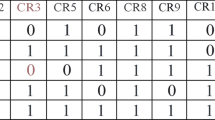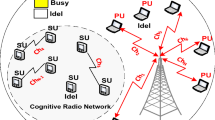Abstract
To increase possible data transmission rate and to provide non-primary user’s desired throughput in short-range communications, in this paper we propose new cognitive radio (CR) network architecture with the coexistence with the legacy IEEE 802.11 WLAN. The legacy WLAN ISM band channel is mostly used for common control channel for cognitive operation on the licensed bands to manage CR devices when they join the network and to announce the utilization of the licensed band or primary system appearance on the current used channels. The proposed CR-WLAN MAC protocol is designed to accommodate new CR related features in the proposed network architecture and it has backward compatibility to the legacy WLAN system: (1) Network entry procedure is modified to inform CR users the current licensed band status and to manage CR user group separately by AP; (2) During the operation, two types of CR beacon multicasting mechanisms are proposed, CR beacons help CR users to decide its service change or spectrum handover and to immediately evacuate from the current used channel when primary signal is detected, (3) When the CR user need to change the serving CR AP, not only the beacon frame body of neighbor APs but also the licensed and unlicensed band status is delivered to CR node to search the target CR-WLAN AP fast and (4) A new type of hidden node problem is introduced that focuses on possible signal collisions between incumbent devices and cognitive radio CR-WLAN devices, and a simple and efficient sensing information exchange mechanism between neighbor APs is proposed. The simulation results show that the proposed CR system can provide reliable protection to primary systems, as well as efficient utilization of given licensed spectrum resources, in which the network throughput can be greatly enhanced.






















Similar content being viewed by others
References
IEEE 802.11. (1999, August). Part 11: Wireless LAN medium access control (MAC) specifications. IEEE standard 802.11.
Simon Haykin. (2005). Cognitive radio: Brain-empowered wireless communications. IEEE Journal on Selected Areas in Communications, 23(2), 201–220.
FCC. (2002, November). Spectrum policy task force report, no. 02-155.
IEEE 802.22-05/0007r47. (2006). Functional Requirements for the 802.22 WRAN Standard.
Akyildiz, I. F., Lee, W.-Y., Vuran, M. C., & Mohanty, S. (2006, September). Next generation/dynamic spectrum access/cognitive radio wireless networks: A Survey. Computer Networks Journal (Elsevier), 50, 2127–2159.
Hsu, A. C.-C., Wei, D. S. L., & Jay Kuo, C.-C. (2007). A cognitive MAC protocol using statistical channel allocation for wireless ad-hoc networks. In Proceedings of IEEE wireless communications networking conference (WCNC’07) (pp. 105–110).
Zhao, Q., Tong, L., & Swami, A. (2005). Decentralized cognitive MAC for dynamic spectrum access. In Proceedings of IEEE symposium on new frontier in dynamic spectrum access networks (DySPAN’05) (pp. 224–232).
Pathmasuntharam, J.-S., & Das, A. (2004). Primary channel assignment based MAC—A multi-channel MAC protocol for multi-hop wireless networks. In Proceedings of IEEE wireless communications networking conference (WCNC’04) (pp. 1110–1115).
Jain, N., & Das, S. (2001, October). A multi-channel CSMA MAC protocol with receiver-based channel selection for multihop wireless networks. In Proceedings of the 9th international conference on computer communications and networks (IC3 N) (pp. 432–439).
Li, J., Haas, Z., Sheng, M., & Chen, Y. (2003). Performance evaluation of modified IEEE 802.11 MAC for multi-channel multi-hop ad-hoc network. In Proceedings of international conference on advanced information networking and applications (AINA’03) (pp. 312).
Chen, J., Sheu, S., & Yang, C. (2003). A new multi-channel access protocol for IEEE 802.11 ad hoc wireless LANs. In Proceedings of IEEE international symposium on personal, indoor and mobile radio communications (PIMRC’03) (pp. 2291–2296).
So, J., & Vaidya, N. H. (2004, May). A multi-channel MAC protocol for ad hoc wireless networks: Handling multi-channel hiden terminals using a single transceiver. ACM international symposium on mobile ad hoc networking and computing (MobiHoc) (pp. 222–233).
Wu, S.-L., Lin, C.-Y., Tseng, Y.-C., & Sheu, J.-P. (2000). A new multi-channel MAC protocol with on-demand channel assignment for multi-hop mobile ad hoc networks. In I-SPAN.
Cordeiro, C., & Challapali, K. (2007). C-MAC: A cognitive MAC protocol for multi-channel wireless networks. In Proceedings of IEEE international symposium on new frontiers in dynamic spectrum access networks (DySPAN’07) (pp. 147–157).
Yuan, Y., Bahl, P., Chandra, R., Chou, A., Ferrell, J. I., Moscibroda, T., et al. (2007). KNOWS: Kognitiv networking over white spaces. In Proceedings of IEEE international symposium on new frontiers in dynamic spectrum access networks (DySPAN’07) (pp. 416–427).
Bahl, P., Chandra, R., Moscibroda, T., Murty, R., & Welsh, M. (2009). White space networking with Wi-Fi like connectivity. In Proceedings of ACM SIGCOMM 2009 (pp. 27–38).
IEEE 802.21 WG. (2007, October). Draft Standard for local and metropolitan area networks: Media independent handover services. Internet-Draft (work in progress).
Kaufmann, A. (1975). Introduction to theory of fuzzy subsets. New York: Academic.
Zimmermann, H. J. (1987). Fuzzy sets, decision making and expert systems. Boston: Kluwer Academic Publisher.
Giupponi, L., & Perez-Neira, A. I. (2008). Fuzzy based spectrum handoff in cognitive radio networks. In Proceedings of cognitive radio oriented wireless networks and communication (CrownCom 2008) (pp. 1–6).
Acknowledgments
This research was supported by the MKE(The Ministry of Knowledge Economy), Korea, under the ITRC(Information Technology Research Center) support program supervised by the IITA(Institute for Information Technology Advancement) (IITA-2009-C1090-0902-0019). This work was supported by the Korea Science and Engineering Foundation(KOSEF) grant funded by the Korea government(MEST) (No. 2009-0079228).
Author information
Authors and Affiliations
Corresponding author
Rights and permissions
About this article
Cite this article
Hao, N., Yoo, S.J. Short-range cognitive radio network: system architecture and MAC protocol for coexistence with legacy WLAN. Wireless Netw 17, 507–530 (2011). https://doi.org/10.1007/s11276-010-0294-7
Published:
Issue Date:
DOI: https://doi.org/10.1007/s11276-010-0294-7




